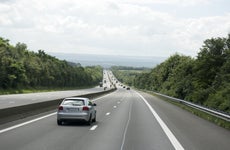Car insurance for high-risk drivers in California

The Bankrate promise
At Bankrate, we strive to help you make smarter financial decisions. To help readers understand how insurance affects their finances, we have licensed insurance professionals on staff who have spent a combined 47 years in the auto, home and life insurance industries. While we adhere to strict , this post may contain references to products from our partners. Here's an explanation of . Our content is backed by Coverage.com, LLC, a licensed entity (NPN: 19966249). For more information, please see our .
California has some of the strictest car insurance regulations in the country, and you may find yourself deemed a high-risk driver if you’re convicted of a violation such as DUI or an at-fault accident. In addition to the civil penalties that accompany your conviction, it’s likely that you’ll pay more for your insurance coverage. Using data from Quadrant Information Services, Bankrate’s insurance editorial team took a deep dive into high-risk auto insurance in California to help you understand how it could impact your insurance coverage and how you might still find affordable coverage that fits your needs.
Rates for high-risk car insurance in California
A driver with a clean record in California pays an average rate of $651 per year for state-mandated minimum coverage, while full coverage, which includes optional collision and comprehensive insurance, averages $2,667. Rates for high-risk drivers generally exceed these averages, as the tables below show. The rate of increase may vary depending on the severity of the violation, however, and number of violations within a certain period of time. Someone with a single speeding ticket, for example, is unlikely to see as much of an increase as the driver who accumulates several speeding tickets within a year.
Because car insurance for high-risk drivers in California can be pricey, it’s important to shop around when looking for affordable coverage, asking for quotes from several insurers to see who offers the cheapest coverage for your situation.
Bankrate collected rates from Quadrant Information Services for multiple insurance companies to help drivers see average rate impacts following different high-risk incidents.
Rates after a speeding ticket
The average annual rate for a driver with a single speeding ticket conviction in California is $889 for minimum insurance and $3,670 for full coverage. That’s a 37 percent increase for full coverage. In addition to this increase, drivers with a speeding conviction will have to pay other fines to the state and may face additional penalties. The cost of a speeding ticket will vary based on how fast you were driving and if your speeding caused an accident.
The table below shows average costs from three insurers for California high-risk auto insurance following a speeding conviction. Note that these numbers reflect a single ticket. You may see a higher rate increase if you have more than one conviction. While your rates will likely differ, these average rates may offer useful points of comparison when you are shopping for your own policyhttps://www.bankrate.com/insurance/car/.
California average annual full coverage premium
| Car insurance company | Rate before a speeding ticket conviction* | Rate after a speeding ticket conviction* | % increase |
|---|---|---|---|
| Kemper | $1,996 | $2,083 | 4% |
| Mercury | $2,050 | $2,910 | 42% |
| Progressive | $2,199 | $2,993 | 36% |
*As of June 2024
Rates after an at-fault accident
After an at-fault accident, your full coverage average rate could increase from $2,667 per year to $4,416—an increase of roughly 65 percent over the average for drivers with a clean record. In addition, you could be held responsible for the other driver’s injuries or property damage. If your own insurance policy limits were lower than these costs, you would be required to pay them out-of-pocket, which could cause financial hardships.
The table below breaks down the average cost of high-risk auto insurance in California based on accident history. However, some car insurance companies charge even higher rates if you have been involved in more than one accident.
California average annual full coverage premium
| Car insurance company | Rate before an at-fault accident* | Rate after an at-fault accident* | % increase |
|---|---|---|---|
| Geico | $2,206 | $3,238 | 47% |
| Kemper | $1,996 | $3,338 | 67% |
| Nationwide | $2,648 | $3,774 | 43% |
*As of June 2024
Rates after a DUI
A DUI is one of the most serious violations you can commit behind the wheel, and both the state and your insurance company are likely to take it seriously. A single DUI conviction increases your average annual rate for full coverage in California to $6,554, while minimum coverage averages $1,604. You are also likely to face other penalties, which could include suspension of your license, probation and hefty fines.
Many drivers with a DUI are required to carry an SR-22, which is a certificate that verifies you carry the minimum amount of insurance required in the state. You might also find that your insurance carrier will not allow you to renew your policy after receiving a DUI, which means you would have to seek coverage from a high-risk insurer. However, coverage from other insurance companies is not guaranteed after a DUI, so it is recommended to speak with an agent to determine eligibility. The table below includes the average cost of high-risk auto insurance for drivers, with and without a DUI conviction applied:
California average annual full coverage premium
| Car insurance company | Rate before a DUI conviction* | Rate after a DUI conviction* | % increase |
|---|---|---|---|
| Kemper | $1,996 | $2,827 | 42% |
| Mercury | $2,050 | $3,637 | 77% |
| National General | $3,139 | $4,386 | 40% |
*As of June 2024
Rate after adding a teen driver
The driver’s age is also a factor in determining car insurance rates. Teen drivers may be considered high-risk drivers because of their lack of experience behind the wheel, even if they have a clean driving record. Insurers consider the general risk of the age group when determining rates, and teens are statistically more likely than any other group to be involved in accidents and engage in unsafe driving practices. Married California parents with a clean driving record pay an average of $2,395 per year for full coverage and $592 for minimum coverage. When you add a teen driver to this policy, the average rates increase to $6,189 and $1,562.
If you are a parent who is adding a teen driver to your policy, you typically won’t need a special high-risk insurance policy. However, your rate will most likely increase after adding them, due to the associated risk to insurers. As your teen driver approaches their early 20s, your rate should start to decrease.
Here is a look at the average cost of car insurance with and without a 16-year-old driver added to their parents’ policy.
California average annual full coverage premiums for married policyholders
| Car insurance company | Rate without a 16-year-old insured | Rate with a 16-year-old insured | % increase |
|---|---|---|---|
| Mercury | $1,843 | $3,977 | 116% |
| Kemper | $1,873 | $4,321 | 131% |
| Geico | $1,810 | $4,457 | 146% |
*As of June 2024
Who is a high-risk driver?
High-risk drivers come in all ages and experience levels. Bankrate defines a high-risk driver as one with at least one speeding ticket conviction, at-fault accident, or DUI conviction on their driving record. Most car insurance companies in California also consider drivers with a DUI conviction or with more than one accident or moving violation to be high-risk.
California’s points system for violations is one of the stricter in the country. Many states may suspend or revoke your license after accumulating six points. California could suspend your license after getting four points in one year. Considering that one at-fault crash may cost you three points for driver negligence, your license could be suspended after a second accident or ticket.
How to lower your rate if you’re a high-risk driver
High-risk drivers may have limited carrier options and higher premiums. However, once you find a carrier willing to write you a policy, there are a few steps you can take to help lower your premium:
- Shop around to find the cheapest car insurance company and most affordable policy based on your current needs.
- Take advantage of as many discounts as possible, like low mileage, student driver or multi-line discounts.
- Enroll in your provider’s telematics program, which collects driving data to support your rededication to safe and responsible driving.
- Complete an approved, eight-hour traffic school course to keep points off your driving record.
- Increase your deductible to a higher amount that you can reasonably afford.
- Maintain a clean driving record by avoiding car accidents and traffic violations.
Saving even as little as 5-10 percent on your vehicle insurance by utilizing discounts could translate to hundreds of dollars per year.
Car insurance for high-risk drivers in California who can’t get standard insurance
If you are considered high-risk and have struggled to find coverage, there may be state resources that can help you. One important one is the California Automobile Assigned Risk Plan (CAARP), which is administered by the American Property Casualty Insurance Association. CAARP is not the same thing as California’s Low-Cost Automobile Program (CLCA), which provides insurance for state residents who cannot afford regular insurance.
CAARP provides liability-only auto insurance to California residents who cannot find regular coverage due to past infractions on their license. When you apply to the CAARP program, you are assigned to an insurance company that will work with you. All the companies working with CAARP are required to charge the same premium levels, so there is no need for you to shop around. Once the infractions have dropped off your record, you should be able to find a standard policy.
Note that CAARP offers only liability coverage; it does not, for example, have collision and comprehensive insurance to help pay for damage to your own vehicle following an accident.
Frequently asked questions
-
No single company always offers the best car insurance in California to every driver. To find the best policy for your own needs, you may want to start with a list of companies writing excellent policies in the state and ask for quotes from several of them to see who offers you the most affordable coverage. Consider your priorities, as well. If you have a teen driver in the house, for example, consider a company that is known for writing robust policies for young drivers. If you’re retired or work from home, on the other hand, you may benefit from a company that offers low-mileage insurance. Other considerations might be related to the quality of the company’s customer service or whether the company has a presence in your town. Once you’ve thought about the most important factors for your policy, you should be able to find an insurer that excels in those areas.
-
Although it’s typically referred to as SR-22 insurance, an SR-22 isn’t an insurance policy. Rather, it is a certificate your auto insurer files on your behalf with your state’s DMV that confirms you carry the minimum amount of car insurance required to drive in California. An SR-22 is generally required after a severe moving violation, like a DUI or reckless driving, to reinstate your driving privileges. The idea of an SR-22 is to ensure high-risk drivers are properly insured in the event they become repeat traffic offenders — data from the NHTSA reports that one-third of all DUIs are actually repeat offenders.
-
All California drivers are required to carry liability insurance with minimums of at least $15,000 in bodily injury and death per person, $30,000 total per accident and $5,000 in property damage. Some high-risk drivers may need their insurers to file an SR-22 form on their behalf, but this is a certificate — not a form of insurance.
-
California assigns zero to three points if you’re a negligent operator (responsible for a car accident). The DMV may suspend or revoke your accident after you accumulate four points on your record in 12 months, six points within 24 months or eight points within 36 months.
Methodology
Bankrate utilizes Quadrant Information Services to analyze June 2024 rates for all ZIP codes and carriers in all 50 states and Washington, D.C. Rates are weighted based on the population density in each geographic region. Quoted rates are based on a 40-year-old male and female driver with a clean driving record, good credit and the following full coverage limits:
- $100,000 bodily injury liability per person
- $300,000 bodily injury liability per accident
- $50,000 property damage liability per accident
- $100,000 uninsured motorist bodily injury per person
- $300,000 uninsured motorist bodily injury per accident
- $500 collision deductible
- $500 comprehensive deductible
To determine minimum coverage limits, Bankrate used minimum coverage that meets each state’s requirements. Our base profile drivers own a 2022 Toyota Camry, commute five days a week and drive 12,000 miles annually.
These are sample rates and should only be used for comparative purposes.
Incidents: Rates were calculated by evaluating our base profile with the following incidents applied: clean record (base), at-fault accident, single speeding ticket and single DUI conviction.
Age: Rates were calculated by evaluating our base profile with the ages 18-60 (base: 40 years) applied. Depending on age, drivers may be a renter or homeowner. Age is not a contributing rating factor in Hawaii and Massachusetts due to state regulations.
Related Articles


California low-cost auto insurance: What to know about the CLCA program

